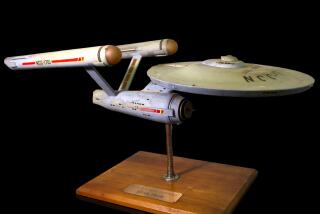FLYING LOW : Models: A Calabasas manufacturer of radio-controlled helicopters tries to overcome a trade dispute and stay airborne.
- Share via
John Gorham, president of Gorham Model Products in Calabasas, said he can’t sleep at night anymore. He mortgaged his home to the hilt and used all his savings trying to keep his tiny firm, which makes radio-controlled model helicopter kits, from going under.
Things are so grim for Gorham that he got a call from his bank last week telling him his personal checking account was $1,000 overdrawn. He instructed the bank to transfer money from the $5,000 he has left from a second mortgage on his house.
“We’re working day by day now,” said Gorham. “All of my moxie is almost gone.”
But not completely. Gorham, 68, still has enough pluck left to hope that he’ll be able to obtain bank financing to buy his company the time he said it needs to recover. Without a loan, he said, he’ll be out of business in three to four months.
Gorham blames his troubles on a Japanese company, Hirobo, which used to be Gorham’s biggest supplier. He said Hirobo undercut him by allowing its Canadian distributors to infiltrate his market in the United States. One of the Canadian companies calls it “free trade.” Gorham calls it “unfair trade practices.”
Either way, Gorham is hurting. After reaching $3 million in sales in 1986 and 1987 and profits of about 9 cents on the dollar, Gorham Model’s sales have sunk to a little more than $1 million and it’s losing about $20,000 a month.
Until May of last year, Gorham was Hirobo’s U.S. distributor for its model helicopters and related parts. Hirobo is a small company by Japanese standards; of its roughly $50 million a year in revenue, only a small percentage comes from sales of helicopter models. It also makes industrial products.
The motor-powered model helicopters are literally scaled-down versions of the real thing, weighing about 5 to 9 pounds and sized up to 1 1/2 feet tall and about four feet long. They are mostly sold in toy and hobby shops and are purchased by a small but growing legion of radio-controlled flying buffs.
Of the 180,000 members of the Academy of Model Aeronautics, an association of flying-model enthusiasts, about 95% fly radio-controlled helicopters and the number keeps increasing, association spokesman Geoffrey Styles said.
Fewer than six companies throughout the world make the helicopter parts, assembly kits and fully constructed models.
The British-born Gorham worked for years as an aerospace engineer and in the late-1960s and early 1970s was the chief engineer of flight guidance and control systems for Lockheed’s L-1011 commercial jet. After leaving Lockheed, he worked as an independent consultant, but in 1978 he became intrigued by the model helicopter hobby and started building and designing his own radio-controlled helicopters.
In 1981, Gorham built and flew 10 model helicopters for Universal Pictures’ “All Night Long,” a movie with Barbra Streisand and Gene Hackman. After filming was completed, he took the models to a trade show and generated enough orders to get his company off the ground. He formed the allegiance with Hirobo in 1983.
But in 1987, Gorham said, his sales of Hirobo products--which then accounted for nearly two-thirds of his total sales--started to drop precipitously. After asking around the industry, he discovered that many American dealers were being supplied with Hirobo helicopter products by two Canadian companies, Udisco in Montreal and Yellow Aircraft in Vancouver. These companies were undercutting his prices--which range from $200 to about $800 per helicopter--by about 30%, he said.
Gorham said he built his business on providing service and technical support to customers, while the Canadian companies are only distributors. However, he would end up giving free service to buyers of the Hirobo products that were sold by the Canadian distributors because there was no way of knowing which distributor provided the models, he said.
Gorham complained to Hirobo about the Canadian distributors and other problems he perceived--such as a lack of quality in a key product line that was allowing a competing company to gain market share and costing Gorham money for repairs and replacements. Eventually, Hirobo executives consented to meet with him, Gorham said.
The meeting, which took place in May, 1989, didn’t produce the results Gorham expected. Afterward, Hirobo stopped all shipments to Gorham and wouldn’t respond to numerous phone calls, letters and faxes, Gorham said.
Lyon Kunin, vice president of Udisco, said he has continued to sell only to dealers in Canada, but argued that there’s little he can do if those dealers sell the products in the United States. “That’s free trade,” he said. “It’s restricting trade if you tell a dealer, ‘You can’t sell here.’ ”
Nonetheless, Hirobo broke its verbal agreement with Gorham by allowing helicopters from other distributors to be sold in Gorham’s territory, said Robert James Terry, a Long Beach-based interpreter who also acted as a consultant to Gorham in his dealings with Hirobo. But, Terry added, Gorham erred by not insisting the agreement be put in writing from the beginning.
“John went into a business arrangement with Hirobo on a handshake,” Terry said. “He made a mistake in dealing with the Japanese in not signing a contract with them.”
Hirobo could not be reached for comment. The company is currently selling its model helicopters in the United States through an Edison, N.J., firm named Altech Marketing.
Virtually overnight, Gorham said his business was nearly devastated. He saw a way out by finding local subcontractors to make replacement parts for the parts he previously bought from Hirobo. He also worked on new designs that he hoped would set new standards for helicopter models.
Gorham’s efforts earned respect from model hobbyists. His helicopters are among the most popular, said Larry Spurling, spokesman for the Radio Control Hobby Trade Assn. Randy Gibson, events coordinator for the International Radio Control Helicopter Assn., said “in a lot of ways the quality has gone up since the separation.”
Gorham also survived by cutting overhead and by digging further into his parts inventory. His staff, once numbering 22, is now down to 15, and “we keep the lights down and the heat off,” he said.
But as Gorham has been busy regearing his company, the expense of creating new products and finding subcontractors has slowly drained his working capital.
“We’re a viable company,” Gorham said. “All we need is a little cash.”
More to Read
Inside the business of entertainment
The Wide Shot brings you news, analysis and insights on everything from streaming wars to production — and what it all means for the future.
You may occasionally receive promotional content from the Los Angeles Times.











